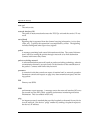
Appendix D. Glossary
61200275L1-1 TSU IQ+ User Manual D-3
bridge
A device that supports LAN-to-LAN communications. Bridges may be
equipped to provide frame relay support to the LAN devices they serve. A
framerelaycapablebridgeencapsulatesLANframesinframerelayframesand
feeds them to a frame relay switch for transmission across the network. A frame
relay capable bridge also receives frame relay frames from the network, strips
the frame relay frame off each LAN frame, and passes the LAN frame on to the
end device. Bridges are generally used to connect LAN segments to other LAN
segments or to a WAN. They route traffic on the level 2 LAN protocol (e.g., the
Media Access Control address), which occupies the lower sub-layer of the LAN
OSI data link layer. See also router.
bursty errored second
See BES.
byte
Generally, an 8-bit quantity of information, used mainly in referring to parallel
data transfer, semiconductor capacity, and data storage. Also, it is generally
referred to in data communications as an octet or character.
carrier
The provider of the T1 service to the customer site. Carriers can be local tele-
phone companies, regional telephone companies or any inter-exchange carrier
such as AT&T, Sprint, or MCI.
CD
carrier detect. A signal generated by a modem or DSU/CSU. CD indicates the
presence of a carrier signal on a communications link.
channel bank
Equipment in a telephone central office or customer premises that performs mul-
tiplexing of lower speed digital channels into a higher speed composite channel.
The channel bank also detects and transmits signalling information for each
channel, thereby transmitting framing information so that time slots allocated to
each channel can be identified by the receiver.
CIR
committed information rate. Less than or equal to the access rate, the CIR is
used by the service provider for rate enforcement when the network is con-
gested. When rates exceed the CIR, frames may be discarded.


















